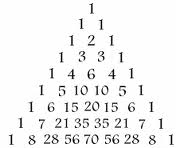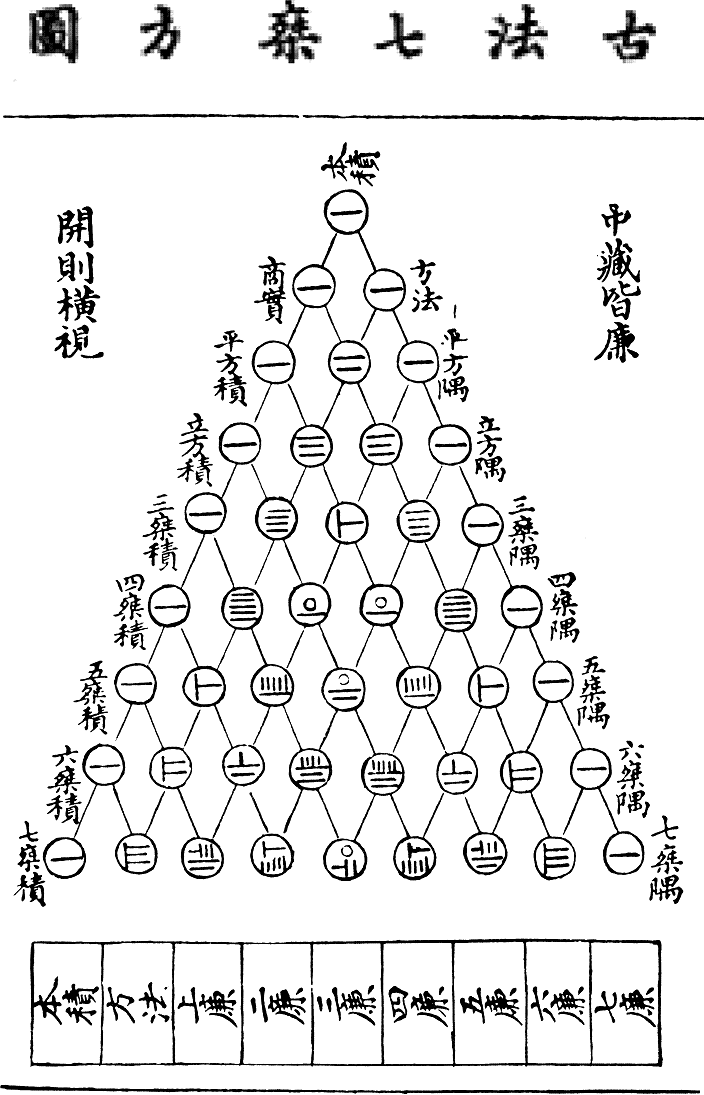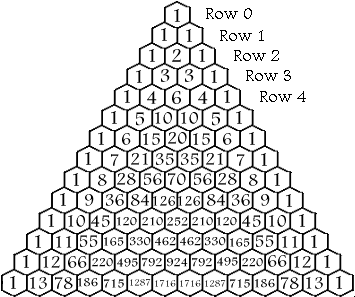- Welcome back from spring break. I hope it was a good one.
- Mine was so good that I didn't even do any grading. I'll have your
homework papers back next time.
- You do have a homework due Thursday.
- Each Flick of a Digit Is a Job for All 5 (New York Times, 2/27/2012)
- Fibonacci Fingers
- This triangle is much older than Blaise
Pascal, who lived in the 17th century (it dates at least to
China, long before -- 13th century AD -- so at about the same
time as Fibonacci was doing his thing in Italy....)


One thing this allows us to do is to understand how this culture wrote its numbers (Chinese Bamboo Counting Rods). How did the Chinese of the 13th century write 15? 28? 30?
- How is it constructed? Easy!

- What's it good for?
- Pascal was interested in gambling -- that's why he studied it so hard.
- How many ways can you put 7 people into 2 cars to go to the party?
- Triangular numbers
- Tetrahedral numbers

- Where's Fibonacci?

- We begin our discussion with the convex regular
polygons:
"A regular polygon is a polygon which is equiangular (all angles are equal in measure) and equilateral (all sides have the same length). Regular polygons may be convex or star."
- As an example, consider your regular convex hexagonal
graph paper, which represents a tiling of the plane by a
regular convex polygon. You see these kinds of tilings in bathrooms.
- Now, let's move on to solids. A cube is an example of a Platonic
solid. It's the one we're most familiar with.
A Platonic solid is a solid for which
- All faces are congruent (identical) convex regular polygons, and
- Each face, each edge, and each vertex is exactly equivalent to every other face, edge, or vertex (respectively).
- We'll start by trying to make some. How many Platonic solids are
there, do you suppose?
- Some of you will make them using magnetic kits ("geomags").
- Some of you will cut them out of paper, using this template
- What's wrong with six sided polygons, and beyond? Consider your
hexagonal paper, of the tiling of the plane: why can't it be folded up
into a solid?
- Johannes Kepler thought that the orbits of the planets (of which
five were known at the time) were somehow related to the various
Platonic solids, as shown in this
figure.
"The six spheres each corresponded to one of the planets (Mercury, Venus, Earth, Mars, Jupiter, and Saturn). The solids were ordered with the innermost being the octahedron, followed by the icosahedron, dodecahedron, tetrahedron, and finally the cube. In this way the structure of the solar system and the distance relationships between the planets was dictated by the Platonic solids."
The Five Convex Regular Polyhedra (Platonic solids) -- thanks Wikipedia! Tetrahedron Hexahedron
or CubeOctahedron Dodecahedron Icosahedron 




- Now let's use our sets of Platonic solids to fill in the
following table:
# of Vertices Edges Faces faces at each vertex sides at each face Tetrahedron Cube Octahedron Dodecahedron Icosahedron What conclusions can we draw from this data? Is there a pattern? (Of course there is!:)